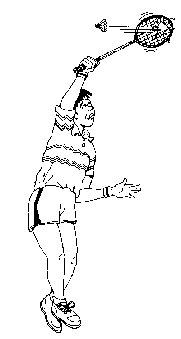|
|

Why Strings Break
By Steve Crandall
Vice President, Sales & Marketing
Ashaway Racket Strings
 A broken string is always a hassle, even if you have a spare racket. It breaks your concentration, and forces you to adjust to a different racket in the middle of a match-which can often mean several lost points.
A broken string is always a hassle, even if you have a spare racket. It breaks your concentration, and forces you to adjust to a different racket in the middle of a match-which can often mean several lost points.
Even with improvements in string technology, breakage is as common as ever, due to the increasing popularity of thinner strings and high stringing tensions. In order to reduce breakage, it is important to understand that it has several different causes. Each may be addressed through a different approach.
The first and most common cause of breakage is stretching the string beyond its elastic limits-similar to pulling a rubber band until it snaps. This usually occurs on one of the central four main strings, within an inch or two of the racket’s head.
The sweet spot is the most resilient-and hence most powerful-area on the racquet. No matter how clever racquet designers may be, they’ll never be able to make the sweet spot extend right to the edge of the racket head. Every time you mis-hit outside the sweet spot, you’re stressing a relatively unresilient section of the string. There’s simply not much string to stretch between the shuttlecock and the edge of the racket, and if the forces are too great, it snaps.
Stringing at lower tension will reduce the incidence of this problem, as will the use of a thicker string. But don’t change both at once. Approach the problem systematically, change one or the other, and play on the new setup for a few weeks before deciding what your next move should be.
Other relatively common causes of breakage are string-to-string abrasion and cutting. Every time you hit the shuttlecock, the cross strings pound against the main strings. In time, they can cut through the outer jacket and into the core. Likewise, "cutting" and spin shots cause the strings to "saw" back and forth against each other, with much the same effect.
Again, thick string withstands this longer than thin string, but there are better ways to resist abrasion and cutting. Some strings have two jackets or wear layers instead of the more common single wear layer. Naturally, two jackets will resist abrasion longer. Jackets may also be either twisted or braided over the core. Braiding is the more durable approach because the over-under-over design locks all the fibers in place. Even after a few jacket fibers have worn through, the jacket as a whole remains intact. In contrast, a twisted jacket may start to unwind as soon as the first fiber is breached.
Over-stressing, and string-against-string forces are inherent in the game. They’re not entirely avoidable, but you can take steps to reduce their effects. Other types of breaks are due to racket defects or carelessness, and can be completely eliminated with proper attention.
A broken, split grommet may present a sharp edge that can cut into the string. If the grommet is missing, the frame itself may cut the string. Next time the strings are out of your racket, feel the edges of the holes that are drilled into the frame: they may be quite sharp.
The simple solution is to make sure the grommets are sound. A new grommet strip may cost $5 or $6: well worthwhile if it saves you a $20 stringing job. If the proper grommet strip is unavailable, your stringer may be able to install a piece of plastic tubing as a temporary repair.
Temperature-related breakage is common in cold climates in the U.S. and Europe. Cold causes the string to contract, significantly increasing its tension. Furthermore, nylon, which is normally a very resilient material, becomes brittle when it’s cold. For both of these reasons, if a racket is taken directly from a cold car trunk and immediately put into hard use, the string can shatter.
The solution to this problem is simple. You can protect the racket from the cold by transporting it in the heated cab of the car, and/or by carrying it in an insulated racket bag. If the racket does get cold, give it several minutes to warm up before putting it into play.
Even with proper care, some string breakage is inevitable. As a string ages, it gradually becomes abraded and loses resiliency. Your best bet is to restring before such degradation occurs: newer strings perform better, and you’ll be surprised less often in the middle of a match.
This article previously appeared in USA Badminton.
|